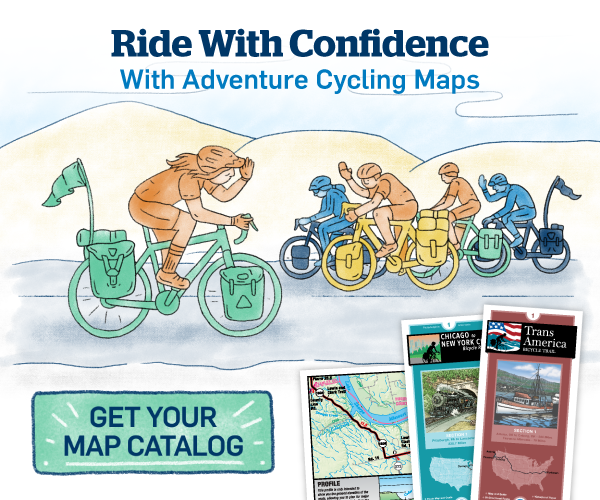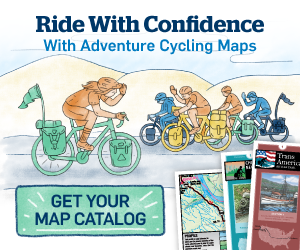FAQs for Planners

Adventure Cycling is proud to be the technical resource center for state and local stakeholder groups in their efforts to develop U.S. Bicycle Routes. We work in partnership with AASHTO.
For more introductory information on the USBRS, see FAQs for Cyclists.
What is the U.S. Bicycle Route System?
The U.S. Bicycle Route System (USBRS) is a developing national network of bicycle routes, connecting urban, suburban, and rural areas using roads, trails, and other facilities appropriate for bicycle travel. Routes are numbered and may be signed.
To date, 19,425 miles of U.S. Bicycle Routes have been established in 34 states: Alaska, Arizona, Arkansas, California, Connecticut, Delaware, Florida, Georgia, Idaho, Illinois, Indiana, Kansas, Kentucky, Maine, Maryland, Massachusetts, Michigan, Minnesota, Missouri, Nevada, New Hampshire, New York, North Carolina, North Dakota, Ohio, Oklahoma, Pennsylvania, Tennessee, Utah, Vermont, Virginia, Washington, West Virginia, Wisconsin, and the District of Columbia.
For maps and other resources to ride an established USBR, visit Ride a U.S. Bicycle Route.
How does Adventure Cycling partner with AASHTO?
The American Association of State Highway and Transportation Officials (AASHTO) is a nonprofit, nonpartisan association representing highway and transportation departments in all 50 states, the District of Columbia, and Puerto Rico. AASHTO’s Special Committee on U.S. Route Numbering reviews U.S. Bicycle Route applications from state departments of transportation and assigns a numbered designation, similar to the U.S. highway system. AASHTO's support for the USBRS is crucial to earning the support of federal and state agencies.
Through our partnership with AASHTO, Adventure Cycling provides training and technical assistance to state DOTs to work through the implementation process with agency staff and partners. The level and kind of assistance will vary from state to state but can include activities such as:
- Drafting of the route;
- coordinating efforts with statewide or local coalitions or advocacy groups; and
- preparing elements of the AASHTO application.
In February of 2021, Adventure Cycling and AASHTO formalized the long-standing partnership with the signing of a memorandum of understanding (MOU) [PDF].
What are corridors?
Corridors are 50-mile wide areas that are used as templates to show planners where a U.S. Bicycle Route could be developed. Corridors are trunk lines that show where and how USBRs will eventually connect states, international borders and other USBRs. They link key destinations, urban centers, and scenic routes, and can be shifted or added by a state department of transportation with concurrence from neighboring states (if affected) and approval from the AASHTO Task Force on U.S. Bicycle Routes. Many corridors suggest development of USBRs along existing bicycle routes or networks, such as the Adventure Cycling Route Network, the East Coast Greenway, the Mississippi River Trail, and the Great Allegheny Passage, among others.
What is the National Corridor Plan?
The National Corridor Plan provides a visual plan for how the USBRS will look when all of the estimated 50,000+ miles of corridors have been completely developed and designated. Undeveloped corridors are depicted as light dotted lines and designated U.S. Bicycle Routes are shown as dark solid lines.
What does designation mean?
Designation signifies that a route is officially recognized and approved with a route number by AASHTO. AASHTO’s Special Committee on U.S. Route Numbering does not approve the suitability of the route for bicycle travel; rather, the committee reviews the numbered designation to ensure a standardized network.
For a route to receive official designation as a U.S. Bicycle Route, it must connect at each end to another state, international border, or existing U.S. Bicycle Route. State or international neighbors must provide a letter of acknowledgement for the route's cross-over point.
For information on the implementation process, read the implementation FAQs below and check out our Implementation pages.
BACKGROUND
How did the USBRS get started?
In 1982, AASHTO approved two U.S. Bicycle Routes: USBR 1 in Virginia and North Carolina and USBR 76 in Virginia, Kentucky, and Illinois. After these two routes were designated, no additional routes were nominated and the project lay dormant for over 20 years.
In 2003, in an effort to reinvigorate the U.S. Bicycle Route System, AASHTO formed a Task Force on U.S. Bicycle Routes, which included Adventure Cycling Association, among other organizations. By 2009, the Task Force had created the National Corridor Plan and the AASHTO application, and formalized a process that states could use to designate USBRs. Adventure Cycling began providing staff support help state partners designate routes in 2005 and continues to be the go-to resource for USBRS information and guidance.
To learn more, visit USBRS History.
How was the Corridor Plan developed?
To get a picture of what already existed, the Task Force on U.S. Bicycle Routes developed an Inventory Report (PDF) and Inventory Map, which documented existing bicycle routes nationwide. The inventory included national routes like the Adventure Cycling Route Network, state bicycle routes, and local bike paths and trails. Using the Inventory Map and corridor criteria, they created the National Corridor Plan, which prioritized and defined numbered 'corridors' for cross-country cycling routes linking destinations, cities, and transportation hubs. The National Corridor Plan suggests the best placement for U.S. Bicycle Routes based on the task force's extensive research; it is intended as a guide for states wishing to implement U.S. Bicycle Routes.
How is the USBRS funded?
There is no dedicated federal funding for the U.S. Bicycle Route System at this time, however federal funding mechanisms exist that are appropriate for USBRs. The USBRS uses existing roads and trails in order to help keep cost of implementation low, and state departments of transportation often build collaborations or use volunteer support when faced with limited staff capacity or funding. Adventure Cycling provides dedicated staff support for system development and receives small grants and donations through our May fundraiser called Build it. Bike it. Be a Part of it.
BENEFITS
See Building Bicycle Tourism resources for more information on bicycle tourism benefits.
Why implement a USBR in my community/state?
U.S. Bicycle Route designation brings significant economic, transportation, environmental, and health benefits and puts communities on the map as a bicycle tourism destination. Designating a USBR creates interstate connections and possibilities for cross-country bicycle travel, bringing out-of-state tourism spending and generating interest in a region. See our building bicycle tourism pages to learn more about how bike travel and the USBRS can benefit your community/state.
Is there demand?
Overall, bicycling and bicycle travel are booming in the U.S.
-
According to the National Sporting Goods Association 95 million adults ride bicycles. U.S. bicyclists have a mean income of about $60,000 and there are more bicyclists than skiers, golfers, and tennis players combined.
-
Adventure Cycling Association has over 48,000 members. Over the last 10 years, the organization has seen a 27% growth in membership and a 42% growth in sales of bicycle-touring maps.
-
The U.S. bicycle industry has annual sales of $6 billion and employs roughly 100,000 people selling 16M bicycles per year according to the National Bicycle Dealers Association. Learn more about its economic impact.
-
Cycling is the sixth most popular recreational activity in the U.S.
-
Other countries that have invested in national systems with success. Visit our International Bicycle Route Networks page.
-
Check out 10 Indicators that Bicycle Travel is Booming press release which documents the growth and trends in bicycle travel and tourism across the world.
IMPLEMENTATION
See the Implementation pages for more detailed instruction on the process of developing USBRs.
How is a USBR designated?
State departments of transportation (DOTs) coordinate the designation process which includes selecting and documenting a route and gaining support from road owners along the route. DOTs submit an application to nominate a USBR for numbered designation through AASHTO. Read more about this process on our Designation page.
Who develops USBRs?
State departments of transportation (DOTs) are ultimately responsible for supporting and overseeing U.S. Bicycle Routes; however, it is often volunteers or other organizations that do the legwork to develop, document and gain support for USBR designation in partnership with the DOT. Check out the USBRS Best Practice Reports to learn more about various models used by state departments of transportation to leverage partnership support for the designation process and promotion.
Is there a route criteria that is used to develop a USBR?
State departments of transportation are encouraged to develop and follow their own selection criteria in conjunction with input from local bicycle organizations and are welcome to consult with Adventure Cycling. There are numerous tools and sample evaluation methods available to assist states with this process which are listed on the Implementation Resources page.
How are U.S. Bicycle Routes Numbered?
East-west USBR corridors are even numbered, and the route numbers generally increase progressively from north to south. North-south USBR corridors are odd numbered, and the route numbers generally increase progressively from east to west. Exceptions have been made for historically significant corridors such as USBR 66 (Route 66).
USBR alternate or spur routes are numbered with three-digit numbers, the first number being an odd or even number (see below), and the last two numbers being the two-digit number of the main route.
-
Three-digit numbers starting with an even number are for alternate routes that diverge and then rejoin the main route. These can be parallel routes or beltway loops. (Example: USBR 235, 435, or 635)
-
Three-digit numbers starting with an odd number are for alternate routes that don't return to the main route or connect two different USBRs. (Example: USBR 121, 321, or 521)
-
Only alternate routes that are 50 or more miles will be displayed on the National Corridor Plan.
If you are considering implementing a new main corridor, a spur or an alternate route in your state, Adventure Cycling can help you with the correct numbering. Contact us at usbrsinfo@adventurecycling.org.
When does AASHTO review and approve USBR applications?
AASHTO’s Special Committee on U.S. Route Numbering reviews USBRS applications twice per year at their meetings in the spring (usually May) and the fall (usually October). Applications are typically due five weeks before the meeting date.
Who maintains USBRs and are there requirements for maintenance?
Because USBRs use existing facilities, the roads, trails, or paths along the route are maintained by its current facility owners. Road and trail owners are contacted for their formal support of a USBR before the route is designated through their jurisdiction. The designation of a USBR along a particular roadway does not mandate any changes in maintenance (such as the addition of bicycle-specific infrastructure), but it is highly recommended to maintain the roadways to be suitable for bicyclists and improve infrastructure when possible. USBRs may be realigned if/when new improvements or bicycle-specific infrastructure becomes available.
When new bicycle facilities are developed along designated U.S. Bicycle Routes, AASHTO recommends that states refer to the AASHTO Guide for Development of Bicycle Facilities for guidance.
Is there any liability from implementing a USBR?
There is no inherent liability for local agencies in designating bicycle routes, and you can find supporting documents on the Implementation Resources page.
Are there funding sources for implementing USBRs?
There is no dedicated funding for the U.S. Bicycle Route System at this time, however federal and state funding mechanisms exist that can be used for U.S. Bicycle Routes. For more information on funding, visit Advocacy Advance’s Federal Funding Resources List. The goal of the USBRS is to use existing roads and trails whenever possible and to build collaborations within states in order to help keep cost of implementation low.


